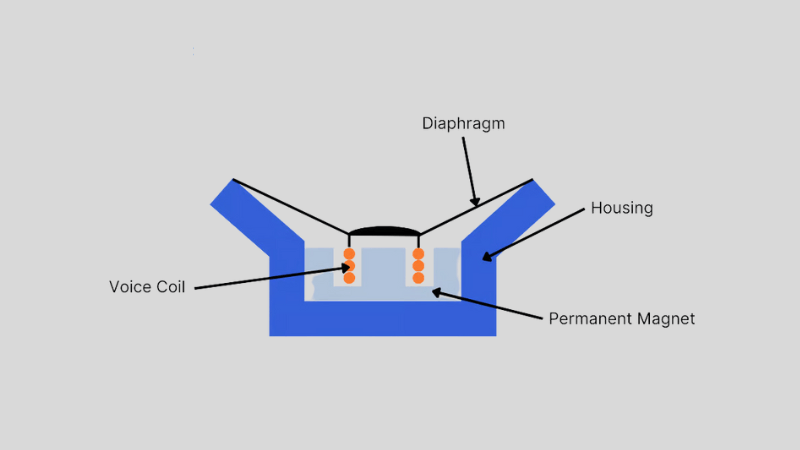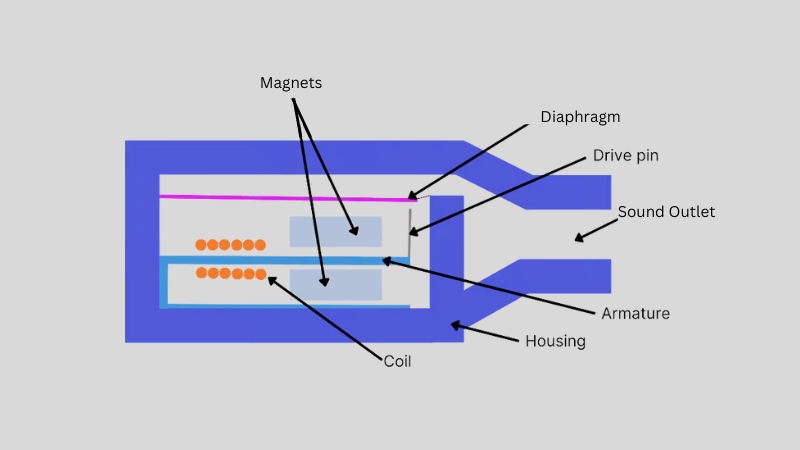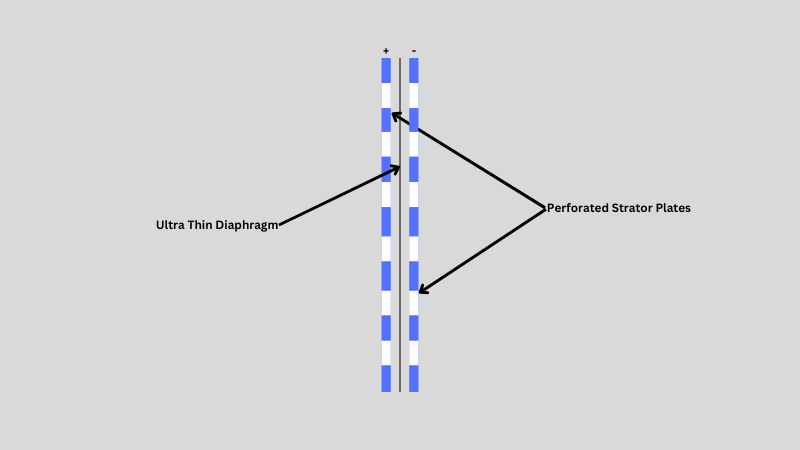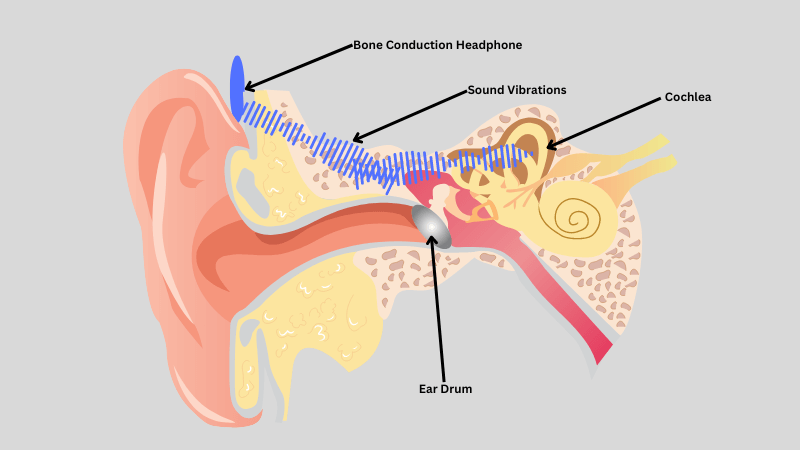When looking at the different types of headphones, you’ve come across dynamic, planar magnetic, or electrostatic drivers, among others. Without the headphone drivers, your headphones would not be able to produce sound signals at all. In this article, we’ll look at the different types of headphone drivers and how they work. Let’s get into the details.
What is a Headphone Driver?
A headphone driver is responsible for turning electrical audio signals into mechanical waves or the sound you can hear. Each type of headphone comes with a single driver on each earcup or earpiece. A headphone driver comes with a diaphragm that moves to create sound. The functionalities of how a diaphragm moves depend on the different headphone drivers.
Because of their difference in operation, the sound of each headphone driver is different from the other. Notably, dynamic drivers are known for their visceral bass response, while electrostatic drivers are known for their clarity in sound and wide frequency response. Let’s look at each of the different headphone drivers.
Types of Headphone Drivers
1. Dynamic Drivers
Dynamic drivers are also known as moving coil drivers. They are the most common type of headphone driver because they are cheaper to manufacture. You’ll find dynamic drivers used everywhere, from iPhone earpods, airplane single-use earbuds, and many of the consumer headphones you see around.
A basic dynamic driver has three main parts: a permanent magnet, a voice coil, and the diaphragm. The voice coil is attached to the diaphragm and sits inside the permanent magnet. When an electrical current is introduced, it travels to the coil, where it creates an electromagnetic field.

The electromagnetic field created interacts with the permanent magnet, which attracts and repels it, causing it to vibrate and move. The movements of the diaphragm are what creates sound. This simple working mechanism makes dynamic drivers use less power and have visceral power to produce a stronger bass response.
However, although they come with a fair amount of advantages, dynamic drivers are prone to distortion at higher volumes. They also have poor treble response compared to other headphone drivers and require damping or tuning to reduce resonant frequencies, especially for closed-back dynamic headphones.
Some good examples of headphones that utilize a dynamic driver include Sennheiser HD800S and Focal Utopia.
2. Planar Magnetic Drivers
Planar magnetic drivers are also called Orthodynamic, isodynamic (meaning equal force), or magneplanar. If you’re looking for a cheaper alternative to electrostatic drivers or a better alternative to dynamic drivers, planar magnetic drivers are recommended.
To produce sound, a planar magnetic driver has two main parts: the diaphragm and two permanent magnets.

The diaphragm of a planar magnetic driver is thin and has thin electrical wires or conductors embedded in it. The diaphragm is then suspended between two permanent magnets. When an electrical signal is applied, it travels through the diaphragm’s thin conductors, creating an electromagnetic field. The electromagnetic field interacts with the permanent magnets, which cause the diaphragm to move with the change of current flowing.
The major advantage of planar magnetic driver design is extremely low distortion across its frequency response, which makes planar headphones sound more natural. The bass response is also very clean and well-controlled.
However, due to the weight and size of magnets, planar magnetic headphones are often bulky and heavy. Most also require an amplifier to power them to sufficient levels. Advancements in technology have reduced the weight and have also made planar magnetic drivers available for In-ear monitors, such as Audeze Euclid and 7Hz Timeless.
Some popular headphones that utilize planar magnetic drivers include Audeze LCD-5, HiFiMAN HE1000 V2, Audeze LCD-2 Classics, and HiFiMAN HE400S. The HE400S is proof of how affordable planar magnetic technology has gotten over the years. We’ve rounded up a list of our best planar magnetic headphones here.
3. Balanced Armature (BA) Drivers
Balanced armature drivers, or BA drivers, are the smallest of all headphone drivers, which is why they are mostly used in IEMs, wireless earbuds, and hearing aids. Because of their smaller size, some manufacturers fit more than one BA driver inside an earpiece, each tuned to handle a specific range of frequency response.
To produce sound, the major elements of a BA driver are the balanced armature (or rod), coil (wraps the armature), magnet, and diaphragm.

When an electric current is introduced, it flows to coils around the balanced armature. And creates an electromagnetic force. The armature is sandwiched between two permanent magnets, and the electromagnetic force created interacts with the magnets, causing the armature to move up or down with the changes in the current.
As the armature moves up and down, it is connected to the drive pin attached to the diaphragm. So, any movement from the armature is translated to the diaphragm. As the diaphragm moves, it reproduces sound, which flows through the sound outlet.
The major advantage of using BA drivers is their smaller size. Several can also be used in a single earpiece to achieve better sound. They are also power efficient, so a smartphone or a digital audio player can drive them effectively. The major disadvantage of using BA drivers is their narrow frequency response, usually fixed by adding more BA drivers to help produce different parts of the frequency response.
4. Electrostatic Drivers
Electrostatic drivers use a very different mechanism from other headphone drivers. The major difference is they don’t use magnets in their structure. Electrostatic drivers use static electricity to produce sound. Apart from not using magnets, electrostatic drivers make electrostatic headphones the most expensive headphones around.
The main parts of an electrostatic driver are its thin diaphragm and two perforated metal plates.

The main working principle of electrostatic drivers is static electricity. The diaphragm is ultra-thin and suspended between the two metal plates that are perforated, also called stators. The space between the diaphragm and stator plates is just enough for the diaphragm to move without getting stuck on either plate.
When current is introduced, it passes through the metal plates and keeps changing the charge, alternating between positive and negative. This action creates static electricity, which pulls or pushes the positively charged diaphragm as the charge alternates as the diaphragm moves air and also produces sound.
An electrostatic driver’s main advantages are their wider frequency response and excellent clarity and transient response. However, they require special amplifiers that generate electrical bias and increase the audio’s voltage while dropping the current before it goes to the driver.
Stax SR-X9000, Audeze CRBN, HiFiMAN Shangri-La, and AAW Canary are some headphones that use electrostatic drivers.
5. Magnetostriction or Bone Conduction Drivers
Bone conduction or magnetostriction drivers are another type of headphone driver that works differently from most. Rather than the drivers reproducing sound, it vibrates, creating sound waves. Rather than sitting inside or on the ear canal, bone conduction headphones sit just above the ear on the temporal bone.
To produce sound, bone conduction drivers have three main parts: the magnetostriction core conductive coil and the diaphragm.

When current is introduced, it travels through the conductive coils, which causes the magnetostrictive core to change shape due to changes in the supplied audio current. As the magnetostriction core expands and contracts, it converts electrical signals to mechanical signs translated to the diaphragm that sits directly on the temporal bone.
As the diaphragm vibrates, the vibrations extend to the temporal bone, inner ear, and cochlea. The electrical impulses are then sent to the brain, where they are deciphered as audio signals.
The major advantages of using bone conduction headphones are they don’t produce noise and can be used without obstructing the ear canal for better situational awareness. Deaf people can also enjoy music with the use of magnetostriction headphones. However, the audio quality is often poor, and the lack of isolation means you cannot enjoy music in noisy places.
Some good examples of bone conduction headphones include Shokz OpenSwim, H2O Audio TRI Multi-Sport, and SHOKZ OpenRun Bluetooth bone conduction running headphones.
6. Hybrid Drivers
Hybrid drivers combine two different headphone drivers in a single earpiece. They are used with IEMs, combining dynamic, planar magnetic, electrostatic, or BA drivers for better sound quality. The most common hybrid drivers around use dynamic and BA drivers to offer better bass response from dynamic drivers, and the BA driver handles mids and high frequencies.
Some examples of hybrid drivers include KZ ZS10 Pro and TRN ST5.
Apart from hybrid IEMs, there is also a new type of headphone driver called the Tribrid driver, which combines three different headphone drivers in a single earpiece. The Moondrop Variations Tribrid IEM uses a dynamic driver, two BA drivers, and two electrostatic drivers. The THIEAUDIO Oracle MKII also with uses the same Tribid combination.